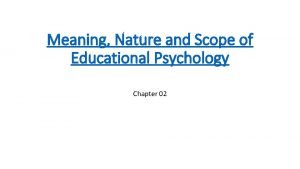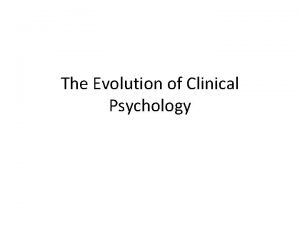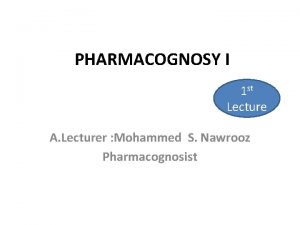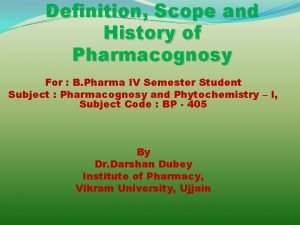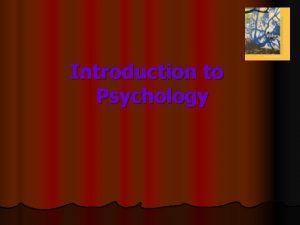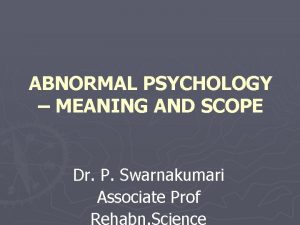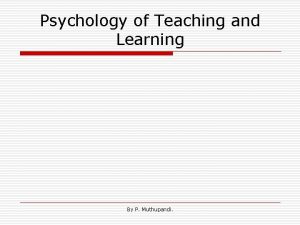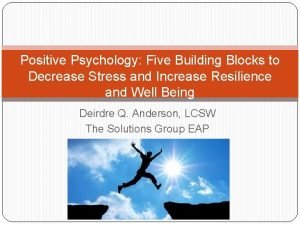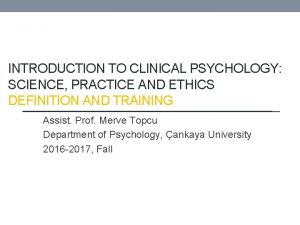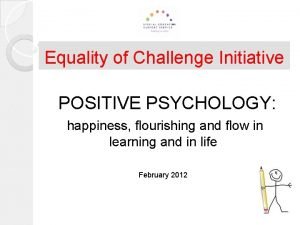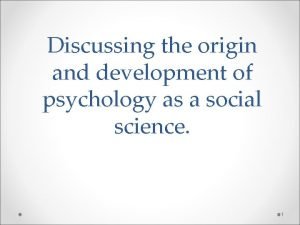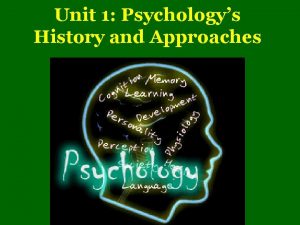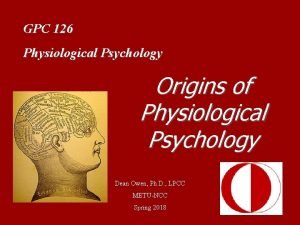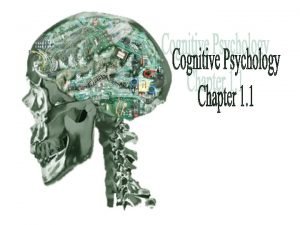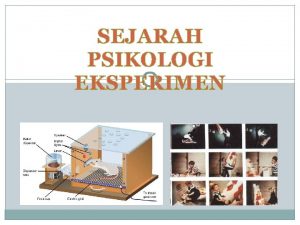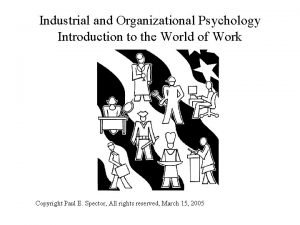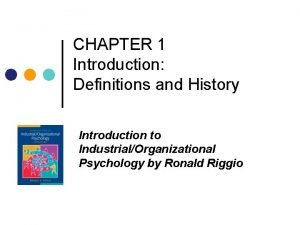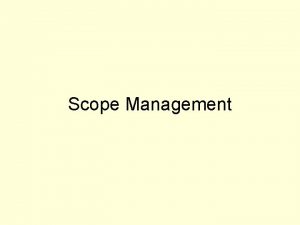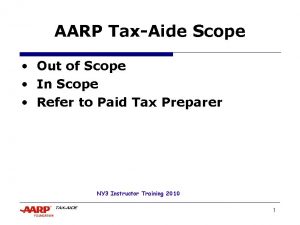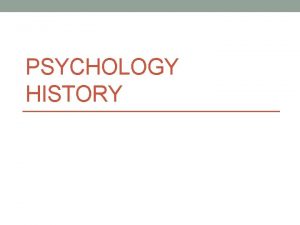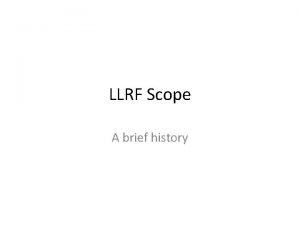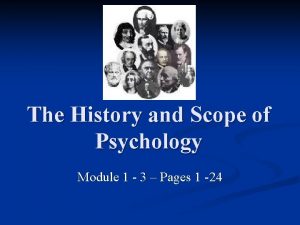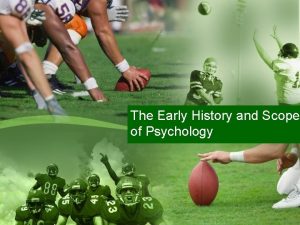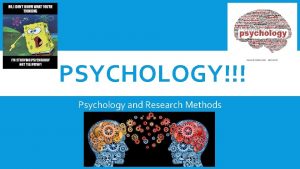THE HISTORY AND SCOPE OF PSYCHOLOGY WHAT IS












































































- Slides: 76

THE HISTORY AND SCOPE OF PSYCHOLOGY

WHAT IS PSYCHOLOGY? A. Define Psychology – a scientific study of human behavior and mental processes 2. It is broken down into various subfields of study. . . a. Biological – Neuronal, brain, hormonal b. Developmental – Life’s changes c. Cognitive – Thought processes d. Personality – Who am I? e. Social – Meeting others. . . e. Harmony. com f. Clinical – Behavior disorders. . . g. Others. . . Sports, forensics

PRE-SCIENTIFIC PSYCHOLOGY Buddha – how sensations and perceptions combine to form ideas Confucius – stressed the power of ideas and of an educated mind Hebrew scholars linked mind and emotion to the body

HERE COME THE GREEKS Socrates & Plato (the student) – concluded the mind can exist without the body Knowledge is innate Aristotle – challenged Soc and Plato – said knowledge is NOT pre-existing, but grows from experiences stored in our memories.

BACK WHEN THE FRENCH MATTERED (just kidding ) René Descartes (1595 -1650) – agreed with Socrates and Plato about innate ideas and the mind’s ability to survive without the body Part scientist, part philosopher Dissected animals & found that their brains contained ‘animal spirits’ that flowed from the brain through nerves to the muscles Memories flowed into the brain through open pores (along with the animal spirits)

ARE WE REALLY A BLANK SLATE? John Locke wrote An Essay Concerning Human Understanding Argued that we are a tabula rasa (a Blank Slate) Helped to form Empiricism The view that 1. knowledge comes from experiences through the senses 2. science flourishes through observation and experimentation.

PSYCHOLOGY IS BORN It all happened on a cold, dreary December day in 1879 in a small, damp room on the third floor of a rundown building at the University of Leipzig in Germany… Two students were furiously working with their professor, Wilhelm Wundt, on an experiment – a machine to measure the time between a person hearing a ball hit a platform and their pressing a telegraph key. As it turns out, people will respond in 1/10 of a sec when they hear a noise, and 2/10 of a second when they wait to recognize the noise

SCHOOLS OF PSYCHOLOGY Wundt: Pursued introspection techniques of consciousness. Really took Psych from philosophical to empirical. Psychology became broken down into different schools of thought Structuralism Functionalism Gestalt psychology Behaviorism Psychoanalysis

STRUCTURALISM Edward B. Titchner Goal was to discover the elements of the mind Engage people in introspection, training them to report elements of their experience as they looked at a rose, listened to a metronome, smelled a scent, or tasted something Wanted to know immediate sensations, images & feelings

STRUCTURALISM Problems with introspection? ? Requires Results smart, verbal people will always vary by person Self-reports and recollections often are wrong We really don’t know why we feel the way we do…

FUNCTIONALISM William James Influenced by Charles Darwin Assumed thinking, like smelling, developed because it was adaptive Contributed to our ancestors’ survival Consciousness serves a function – enables us to consider our past, adjust to our present circumstances, & plan our future… Functionalism = a school of psych that focuses on how mental and behavioral processes function – how they enable the organism to adapt, survive, and flourish

THE SCHOOLS Biological – hormones, genes, the CNS Evolutionary – Natural selection and adapting to the environment promoted one’s survival. . . Psychodynamic – unconscious is examined. Childhood conflicts exposed. Behavioral – One’s actions created by rewards + punishments. Cognitive – Thoughts + mental processes Engineering Psych – The Human factor Humanistic – One’s attempt to become unique and achieve one’s potential. In total – many Psychologists take an eclectic approach to examining behavior.

SOMETHING ELSE YOU SHOULD KNOW… Fechner – studied mental processes while observing one’s reactions to sensory stimuli. Established psychophysics study

IS IT REALLY THAT HARD TO DEFINE PSYCHOLOGY? Wundt and Titchner focused on inner sensations, images, & feelings James focused on introspection Freud emphasized emotional responses to childhood experiences & our unconscious thoughts James Watson introduced behaviorism Carl Rogers and Abraham Maslow focused on humanistic approach Role of environment on current situations

COGNITIVE PSYCHOLOGY Supports ideas of considering internal thoughts as well as scientific methods for the ways we perceive, process and remember information

NATURE VERSUS NURTURE Nature vs. nurture: the conflict between the contributions genes and experience make to the development of psychological traits and behaviors The use of twins in studies Darwin’s natural selection (survival of the fittest) Traits that have proven successful will be passed to the next generation

WEBSITE http: //bcs. worthpublishers. com/myers 8 einmodules/defaul t. asp

THE BIOPSYCHOSOCIAL APPROACH Biological Influences: - genetic predisposition - genetic mutations - natural selection of adaptive behaviors & physiology - genes responding to the experiment Psychological Influences - learned fears and expectations - emotional responses - cognitive processing & perceptual interpretations Behavior or Mental Processes Socio-Cultural Influences - presence of others - cultural, societal & family expectations - peer & other group influences - compelling models (media)

PERSPECTIVE FOCUS STUDIES Neuroscience How the body & brain enable emotions, memory and the senses -brain circuits that control ‘being red in the face’ when angry Evolutionary How the natural selection of traits promotes the perpetuation of one’s genes - How anger facilitated their ancestors survival Psychodynamic How behavior springs from unconscious drives and conflicts - An outburst as an outlet for unconscious hostility Behavioral How we learn observable responses - Study facial expressions and body language that come with anger Cognitive How we encode, process, store - How anger affects a person’s & retrieve info. thinking & reactions Social-cultural How behavior & thinking vary across situations & cultures - Which situation produces the most anger & how it varies by culture

BASIC RESEARCH 1. 2. 3. 4. 5. Pure science that aims to increase the scientific knowledge base Biological Psychologists: explore the links between brain and mind Developmental Psychologists: Study our changing abilities from womb to tomb Cognitive Psychologists: Experiment w/ how we perceive, think, & solve problems Personality Psychologists: Investigating our personality traits Social Psychologists: How we view & affect one another

APPLIED RESEARCH Scientific study that aims to solve practical problems

FYI… Counseling psychologist – assists people w/ problems in living (school, work or marriage) & in achieving greater wellbeing Clinical psychology – studies, assesses & treats people w/ psychological disorders Psychiatry – branch of medicine dealing w/ psychological disorders; practiced by physicians who sometimes provide medical treatments (drugs) as well as psychological therapy

THINKING CRITICALLY WITH PSYCHOLOGICAL SCIENCE Chapter 1 Myers

SOCIOCULTURAL FACTORS THAT IMPACT Humans are humans but the similarities stop there. . . Culture is. . . the way one lives. . . Impacts behavior a)Individualistic cultures – Personal goals b)Collectivist cultures – Group goals

Since it is so new. . . Psych has had a difficult time establishing a foundation because it lacks “EMPIRICAL” evidence. . . which is the attempt to collect data. . . so one can evolve from the “I think”. . . To the “I know” category Intuitions experiment…

WEBSITE!! http: //www. intropsychresources. com/ This is an online text that can provide additional information for topics you may have a hard time understanding

PSYCHOLOGICAL RESEARCH a. Critical thinking evolves around 5 stages (1) What am I being asked to believe or accept? (2) What evidence is available to support my assertion? (3) Are there alternate paths to my conclusion? (4) What additional evidence would help to evaluate the alternatives? (5) What logical conclusions are evident. . . What makes the most “sense”?

RESEARCH COMMONALITIES a. Hypothesis --Your best guess b Operational Definitions -Specific steps to completing the research. . . The How to c. Variables : - Factors that are manipulated d. Data. . . objective. . . quantifiable e. Reliability – Can it be repeated f. Validity - Assessment of the topic at hand. . . g. Theories – Predictions on why it happens. . . h. Laws. . . It’s a pretty sure phenomenon

THE SCIENTIFIC METHOD

GOALS OF THE SCIENTIFIC METHOD 1. Describe the Phenomenon 2. Make Predictions about the phenomenon 3. Establish enough control over the procedures to provide for an. . . 4. Explanation of the phenomenon. .

FIVE RESEARCH METHODS a. Natural Observation (1)WYSIWYG (what you see if what you get) (2) Will participants change their behavior because you are there? (3) Doesn’t explain why. . . will observer make inferences? b. Case Studies (1) intensive study (2) not representative (3) Psychologists determines what is important. . . may overlook critical data. (4) LONGITUDINAL, (5) cross-section

CASE STUDY Psychologists study one individual in great depth in the hope of revealing things true of all of us. Can suggest hypotheses for further study Also show what can happen Remember this: individual cases can suggest abundant ideas, but we need to use other methods to come up with generalizations about the entire population

Stress Management Picture yourself near a stream. Birds are singing in the crisp, cool mountain air. Nothing can bother you here. No one knows this secret place. You are in total seclusion from that place called the world. The soothing sound of a gentle waterfall fills the air with a cascade of serenity. The water is clear. You can easily make out the face of the person whose head you're holding under the water. There now, feeling better?

FIVE RESEARCH METHODS CONTINUED c. Surveys (1) Asking the right questions. . . (2) Will audience tell you what you want to hear? (3) Do participants represent population? (4) Lot’s of data at a small price. d. Correlative studies (1) Relationship between variables (a) Positive – strong tendencies (b) Negative, Opposite tendencies (c) None – No tendencies (2) Does not show cause + Effect 3. Challenger Demo 1+2

POSITIVE CORRERALTION + 1. 00

NO RELATIONSHIP 0. 00

PERFECT NEGATIVE CORRELATION -1. 00

CORRELATION STUDIES CONTINUED Positive correlation = 2 sets of scores tend to rise and fall together Calories No correlation = the sets of scores have no effect on each other Calories consumed and weight consumed and amount of sleep Negative Correlation = the 2 scores relate inversely (1 goes the other goes ) As tooth brushing goes up, tooth decay goes down

THE LAST RESEARCH METHOD EXPERIMENTS 1. Tests (or measures. . . ) 2. Cause-effect Manipulation of variables Independent (IV) – Experimenter manipulates Dependent (DV) - Observed by experimenter because it happens because of IV (Note: One is testing the effect of ___ on ___. ) Confounding or Random. May also impact DV’s

EXPERIMENTS - CONTINUED 3. Group Assignments (a) Experimental – Gets the IV (b) Control – No treatment (c) Assignment – • Sampling reflects total population – Random • Group Assignment – is also random

EXPERIMENT MODEL 4. a) (b) (c) Flaws – Placebo effect Experimenter bias – double Blind theory. Ethics violations

HINDSIGHT BIAS The tendency to believe after learning as outcome, that one would have foreseen it (I-knew-it-all-along) Errors in human recollection show why we need psychological research… Researchers have found hindsight bias in studies across the world and across age-groups

HINDSIGHT BIAS EXAMPLE Unscramble these words 1. 2. 3. Answers WREAT 1. WATER 2. ENTRY 3. BARGE ETRYN GRABE

COLLECTION OF DATA Analyzing the data (1) Descriptive Stats – A summary of. . . ((a))Measures of Central tendency ((1)) Mode – Value of # that occurs most often. . ((2)) Median – halfway point. ½ above. . . 1/2 below ((3)) Mean – the average. It is affected by actual value of each score. Example – 1, 2, 2, 3, 5 6, 7, 8, 8, 8, Mode = 8 Median = 5/6 Mean = 5

MEASURES OF VARIABILITY – (1)Range – Difference between Highest + lowest score (2) Standard Deviation – Ave difference between each score + the mean of the data set. Higher the SD, the more variability of data. i. e. +1, +2, +3. . . (3) Correlation – how strongly one variable relates to another. . . 0 to +1 ((a)) Correlation coefficient = r. . . an “r” greater than 0 is positive. . . an “r” less than zero is negative. ((b)) on a “curved” distribution. . . If data is plotted on the left. . . that is positive skew If data is plotted on the right. . . that is a negative skew

HUMAN DEVELOPMENT

DATA CAN’T TELL THE WHOLE STORY a. Behaviorial genetics. The beginning of the nature v. nurture controversy (1) The hunt for DNA (a) Chromosomes are string like molecules comprised of DNA, Each of us has a slightly different set of copied exactly into each body cell. Humans have 46 separate chromosomes arranged in 23 matching pairs. (2) Each chromosome has thousands of functional units called genes. (3) During reproduction - When a sperm fertilizes an ovum, the 23 chromosomes of each cell match up (meiosis) to produce a new single cell called a zygote with a complete set of 46 chromosomes specifying a blueprint of a completely new heritage.

MORE ABOUT YOUR GENETIC MAKEUP (4) Your particular DNA code is your genotype. Some genes are used more “strongly” than others. Thus, your phenotype, or how you actually look and act, is not always a clear-cut manifestation of genotype. (a) Dominant genes are DNA codes that are always expressed in the phenotype when such codes exist in an organism’s genotype. (b) Recessive genes are DNA codes that are only expressed in the phenotype when there are no dominant genes coding for the same type of protein in the organism’s genotype. .

AND MORE…. (1) Family studies explore the extent to which behavioral tendencies, like genes, tend to “run in the family. ” A problem with such studies is that common environments also run in families, and may explain behavioral similarities. Soo o o is it nature or is it nurture? ?

TWIN STUDIES These studies stem from the fact that identical, or monozygotic twins result from the duplication and separation of the same zygote, so they are genetically identical. Non-identical twins result from two separate zygotes, and thus are genetically unique. Adoption studies : examine the behavioral similarity of biological families, who share similar genes, but who have been raised separately from birth, This provides an excellent venue for proving nature as a dominant factor. . .

NATURE AND NURTURE ARE INEXTRICABLY INTERTWINED (1). Nature and nurture help make people similar. i. e. (2). Nature and nurture also help make people different. Inherited genes underlie variations in personality, IQ, speech (3). Genetics gives a child a broad range of ability, w/in which env can “push” a child up or down. (4). Variations in heredity and env are often confounded. i. e. Intelligent parents may give their children genes that increase intelligence as well as a more intellectually stimulating env. **So the Literature is “Mixed” on this topic so far**

HUMAN DEV + HUMAN BEHAV 1. Developmental Psych deals w/ a person’s physical + psych maturation over time. a. Is it nature or is it nurturing that provides for these life changes. (1). Locke and his famous tabula rasa. . NU rules (2) Rousseau thought childhood was a unique experience and a child had a charted course so let NA rule (3)Gesell – Motor development was fixed stages called maturation. NA provided the course. (4) Watson – NU ruled a child learned everything thru RF’s! (5) Piaget – NA + NU were inseparable b. Sooooo. . . some phenomena are more influenced by environment and others by established predispostions thru heredity.

MAKING A BABY. . . IT’S A LOT EASIER THAN ONE THINKS. . . a. Sperm fertilizes an ovum, creating a single cell Zygote. This occurs during a natural event called sex, or procreation; OR during a procedure called artificial insemination. (1) Geminal stage- Zygote duplicates – 2 wks (2) Embryonic stage – Embryo is formed + basic body is created – 6 wks – critical period. . . (a) Terantogen’s can invade this critical period. i. e. Fetal alcohol syndrome, “crack babies”. . i. e. smoking can make babies weigh less at birth. (3) Fetal Stage – Womb development And after about nine months or so. .

A HUMAN ARRIVES. . . IT’S A BABY. . . w/no directions. Some things work, some don’t. . . (1). It eats, by sucking. It wets. . . it sleeps (2). But It can’t see very well. . . no depth perception by seven months. . . (a) Newborns lack a fovea, the part of the eye onto which images are focused. Brain areas that process visual info are still poorly developed. (b) Hearing is impaired at birth by amniotic fluid in the ears. A few days after birth, newborns hear soft voices, locate sounds, and discriminate tones. They prefer rising tones and expressive speech (baby talk).

(3). Newborns have smell and taste preferences. They can discriminate the tastes of water, sugar water, and milk. (4) Movements during the first few months are dominated by involuntary, unlearned reactions, called reflexes. Over 20 reflexes have been observed in newborns, including the grasping, rooting, and sucking reflexes.

PIAGET’S COGNITIVE DEVELOPMENT a. Cognitive Development -- Cog theory by Piaget saw the ability to think as growing in a fixed sequence of stages, Each stage of cog dev is a different way to think. (1). Piaget viewed intell as units comprised of schemas, that apprehend and manipulate the world. They are experience-born generalizations to organize the past and predict the future. They may be actions, simple thots, or complex ideas. (2) When people are satisfied, a sense of equilibrium exists; when people are confused or frustrated or pondering. . . a sense of disequilibrium exists, promoting learning.

MORE ABOUT PIAGET’S STAGES (a) In assimilation, people use an existing schema to fit a new experience and gather information from it. i. e. When you put a finger in an infant’s hand, it uses its grasping reflex to hold onto your finger. (b) In accommodation, people modify an existing schema to better fit and gather information from a new experience. i. e. If you put a beach ball on an infant’s hand, its grasping schema will not work. The infant may modify its behavior to simply caress the ball.

PIAGET’S STAGES OF COGNITIVE DEVELOPMENT Typical Age Range Description of Stage Developmental Phenomena Birth to nearly 2 years Sensorimotor – experiencing the world through senses and actions (looking, touching, mouthing, grasping) • Object Permanence • Stranger Anxiety 2 to about 6 -7 years Preoperational – representing things with words and images; use intuitive rather than logical reasoning • Pretend Play • Egocentrism • Language Development 7 – 11 years Concrete Operational – Thinking • Conservation logically about concrete events; • Mathematical transformations grasping concrete analogies & performing math operations About 12 - Adulthood Formal Operational – Abstract reasoning • Abstract logic • Potential for mature moral reasoning

WITH COGNITIVE DEVELOPMENT COMES a. Child’s attitude development – temperment (1). How a child expresses oneself is based on how the child interacts w/ parents, its natural development + its nurturing. Thomas + Chess call it the “goodness of fit” (a) Easy babies (b) Difficult babies (c) Slow to warm babies

ATTACHMENTS – THE ENDURING RELATIONSHIP a. Harlow + the monkey’ relationship Does the baby “know” when life is amisss (1) Warm + fuzzy Mom v. “cold steely mom. (2) Theory – Attachments seem to follow “contact comfort” v. fulfilling basic needs. Human babies are similar. They desire that TLC b. Neglected babies tend to be. (1) Avoidant to mom when she approaches (2) Ambivalent-upset when “M” leaves + return (3) Disorganized. Children need “time” w/ parents. Mom’s + Dads

c. Ainsworth – “Strange Situation” – Babies return to mom if it feels “secure with mom. . . If not, if will be ambivalent toward mom or even ignore mom. d. Vygotsky claims children need interaction w/ society + culture to dev scripts. IF child does not have contact with these cultural connections, the child could develop cognitively or socially without human guidelines. . . like being raised in the wild. . . OR Wildboy mentality.

SOCIAL RELATIONSHIPS – ERICKSON a. 8 social stages – He saw personality development as following a series of eight “psychosocial crises, ” each building on earlier ones. b. How, and how well, one resolves each crisis adds to the ongoing and lasting edifice of emotional development.

BAUMRIND’S PARENTING STYLES. . . Parenting styles - There are distinct patterns of socialization or parenting styles. Baumrind (1) Authoritarian parents are firm, punitive, + unsympathetic. They value obedience from their children. 2). Permissive parents give their children complete freedom with little discipline. 3). Authoritative parents reason with their children, giving greater responsibilities with age. They set firm limits but also remain understanding and encourage independence.

PARENTING STYLES CONTINUED Socialization styles may affect a child’s social and emotional development. (1). Authoritarian parents’ children tend to be unfriendly, distrustful, and withdrawn. (2) Permissive parents’ children tend to be immature, dependent, and unhappy. (3) Authoritative parents’ children tend to be friendly, cooperative, and self-reliant. (4) Socialization styles may also mold children’s moral behavior.

GENDER ROLE DEVELOPMENT a. Many social roles that children learn are linked to gender. They are rooted in both nature and nurture. (1) Girls aren’t athletes, Males are. . . Males are pushed toward sports, females pushed dancing, cheering etc. (2) Susie homemaker, domesticated; males will bring home the bacon. b. In the 90’s women began taking a stand. Corporate climbing. . . but is it a valid or token move. Aren’t women prez only running women stuff companies? c. Moving into more male-oriented fields. d. 180 world leaders, two are female

SOME INTERESTING FACTS/PRESUMPTIONS ABOUT GENDER DIFFERENCES… 1). Technology -- Service economy 2). Quotas – Title IX 3). Women cook, clean and raise the chillin’s 90% 4). Who is the wage earner? 5. ) single moms need the cash too. 6). Courts see females as the mother. 7). Females love literature becuz that ‘s where all those romantic novels come from and poetry speaking about LOVE!! 8). Boys don’t like love but they love math and sci

WHY THE GENDER DIFFERENCES? Gender roles are rooted, in part, in biology. a. ) Girls mature faster physically, are less susceptible to illness, and have fewer difficulties with speech, learning, sleep disorders, mental retardation, and emotions. b. ) Girls speak and write earlier and more fluently. Boys are more skilled at manipulating objects, constructing three- dimensional forms, and mentally manipulating figures and pictures.

WHY GENDER ROLES CONTINUED… c. ) Girls are less physically aggressive, form smaller groups, play in smaller spaces, and spend more time exploring social rules and roles. Boys tend to play more strenuous and noisy games. d. ) The biological nature of these differences is evident in anatomy, hormones, and brain organization, and cross-cultural demonstration of consistent gender patterns despite very different socialization. 1) So why fight city hall. . . this lays a foundation to a well-organized society.

2. Gender roles are nurtured by social interactions and environmental cues. From birth, boys and girls are treated differently. a. ) Parents pass on ideas about “appropriate” behaviors for boys and girls. Example: Boys tend to receive encouragement to achieve, compete, and act independently, while girls are more often encouraged to be expressive, nurturer, dependent

ADOLESCENCE -- PUBERTY I. Adolescence - Puberty THE BIG SHAKEUP, the wonder years, thunder years, the most difficult time period in human development until. . you turn 40 or 50. 1. Adolescence begins with a sudden growth spurt. Puberty, the beginning of reproductive capability, causes dramatic bodily changes+ Sexuality becomes a major theme of adolescence. 2. Adolescent changes and pressures often cause family conflicts. a) Such conflicts often center on the teen’s need to experience life on her or his own terms. By age 14, adolescents often say that their relationships with their peers are closer than those with their parents. But teens also see their parents as the #1 role models in their lives. . .

MORALITY– KOHLBERG 1. 2. 3. Preconventional Morality – Before Age 9, most children have a preconventional morality of self-interest. They obey to either receive awards or avoid punishment Conventional Morality – by early adolescence, morality usually evolves to a more conventional level that cares for others and upholds laws and social rules simply because they are laws and rules Postconventional Morality – Some of those who develop the abstract reasoning of formal operational thought may come to a third level. Postconventional morality affirms people’s agreed-upon rights or follows what personally perceives as basic ethic principles.

DEATH AND DYING 1). A few years or months before death, people often show a sharp decline in mental functioning known as terminal drop. The awareness of impending death is the last psy crisis, as people review, evaluate, and try to integrate their lives and accomplishments.

STAGES OF DYING – KUBLER-ROSS a. Denial + isolation – A typical first reaction is to deny death’s reality and isolate one self from information confirming death. May be sure that “it’s all mistake. ” This sort of denial may proceed attempts to avoid reminders of the situation. b. Anger – Many dying individuals feel anger and ask “Why Me? ” Their anger may spill over into rage toward the living, even towards good friends.

DEATH AND DYING… c. Bargaining – The terminally ill bargain with themselves or God. One may think “Just let me live and I do anything. . . ” or “I will never smoke again. ”, trying to right past wrongs. d. Depression – Feelings of futility and exhaustion + deep depression may set in. The person realizes they will be separated from friends, family, etc. and this knowledge causes sadness.

WE’RE STILL TALKING DEATH… e. Acceptance – People manage to come to terms with dying and accept it. The person is neither happy nor sad, but at peace. Acceptance usually signals that the struggle is resolved, the need to talk about death ends and silent companionship is all they want. NOTE: This doesn’t always occur in fixed stages like many of the other theories stated above. But there is a cycle effect going on. Possible 6 th effect: Relief for you and the one passing on. . .

THE END
 Meaning nature and scope of psychology
Meaning nature and scope of psychology Product scope vs project scope
Product scope vs project scope Use case diagram
Use case diagram Nature of clinical psychology
Nature of clinical psychology Psychology studies
Psychology studies Pharmacognosy scope
Pharmacognosy scope Definition history and scope of pharmacognosy
Definition history and scope of pharmacognosy Victorian curriculum history
Victorian curriculum history Scope of psychology
Scope of psychology Scope of abnormal psychology
Scope of abnormal psychology Educational psychology meaning
Educational psychology meaning History of positive psychology
History of positive psychology Clinical psychology science practice
Clinical psychology science practice Scope of positive psychology
Scope of positive psychology Cie
Cie Psychology definition
Psychology definition History and origin of science of psychology slideshare
History and origin of science of psychology slideshare Unit 1 psychology's history and approaches
Unit 1 psychology's history and approaches Hát kết hợp bộ gõ cơ thể
Hát kết hợp bộ gõ cơ thể Lp html
Lp html Bổ thể
Bổ thể Tỉ lệ cơ thể trẻ em
Tỉ lệ cơ thể trẻ em Chó sói
Chó sói Tư thế worm breton
Tư thế worm breton Chúa sống lại
Chúa sống lại Các môn thể thao bắt đầu bằng tiếng chạy
Các môn thể thao bắt đầu bằng tiếng chạy Thế nào là hệ số cao nhất
Thế nào là hệ số cao nhất Các châu lục và đại dương trên thế giới
Các châu lục và đại dương trên thế giới Công thức tiính động năng
Công thức tiính động năng Trời xanh đây là của chúng ta thể thơ
Trời xanh đây là của chúng ta thể thơ Mật thư anh em như thể tay chân
Mật thư anh em như thể tay chân Phép trừ bù
Phép trừ bù Phản ứng thế ankan
Phản ứng thế ankan Các châu lục và đại dương trên thế giới
Các châu lục và đại dương trên thế giới Thơ thất ngôn tứ tuyệt đường luật
Thơ thất ngôn tứ tuyệt đường luật Quá trình desamine hóa có thể tạo ra
Quá trình desamine hóa có thể tạo ra Một số thể thơ truyền thống
Một số thể thơ truyền thống Cái miệng nó xinh thế chỉ nói điều hay thôi
Cái miệng nó xinh thế chỉ nói điều hay thôi Vẽ hình chiếu vuông góc của vật thể sau
Vẽ hình chiếu vuông góc của vật thể sau Nguyên nhân của sự mỏi cơ sinh 8
Nguyên nhân của sự mỏi cơ sinh 8 đặc điểm cơ thể của người tối cổ
đặc điểm cơ thể của người tối cổ Thế nào là giọng cùng tên
Thế nào là giọng cùng tên Vẽ hình chiếu đứng bằng cạnh của vật thể
Vẽ hình chiếu đứng bằng cạnh của vật thể Tia chieu sa te
Tia chieu sa te Thẻ vin
Thẻ vin đại từ thay thế
đại từ thay thế điện thế nghỉ
điện thế nghỉ Tư thế ngồi viết
Tư thế ngồi viết Diễn thế sinh thái là
Diễn thế sinh thái là Các loại đột biến cấu trúc nhiễm sắc thể
Các loại đột biến cấu trúc nhiễm sắc thể Bảng số nguyên tố lớn hơn 1000
Bảng số nguyên tố lớn hơn 1000 Tư thế ngồi viết
Tư thế ngồi viết Lời thề hippocrates
Lời thề hippocrates Thiếu nhi thế giới liên hoan
Thiếu nhi thế giới liên hoan ưu thế lai là gì
ưu thế lai là gì Khi nào hổ con có thể sống độc lập
Khi nào hổ con có thể sống độc lập Khi nào hổ con có thể sống độc lập
Khi nào hổ con có thể sống độc lập Hệ hô hấp
Hệ hô hấp Từ ngữ thể hiện lòng nhân hậu
Từ ngữ thể hiện lòng nhân hậu Thế nào là mạng điện lắp đặt kiểu nổi
Thế nào là mạng điện lắp đặt kiểu nổi Positive psychology ap psychology definition
Positive psychology ap psychology definition Ap psychology chapter 13
Ap psychology chapter 13 Fundamental attribution error ap psychology
Fundamental attribution error ap psychology Social psychology is the scientific study of
Social psychology is the scientific study of Health psychology definition ap psychology
Health psychology definition ap psychology What is psychology
What is psychology Physiological psychology
Physiological psychology History of cognitive psychology
History of cognitive psychology Forensic psychology history
Forensic psychology history History of cognitive psychology
History of cognitive psychology A brief history of psychology
A brief history of psychology History of cognitive psychology
History of cognitive psychology History of sport psychology
History of sport psychology Tokoh psikologi eksperimen
Tokoh psikologi eksperimen Timeline of the history of i/o psychology
Timeline of the history of i/o psychology History of forensic psychology
History of forensic psychology History of organizational psychology
History of organizational psychology
